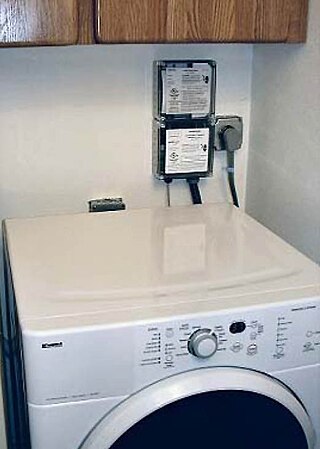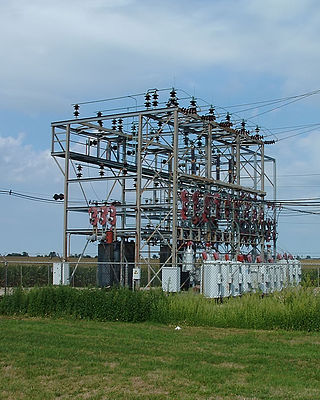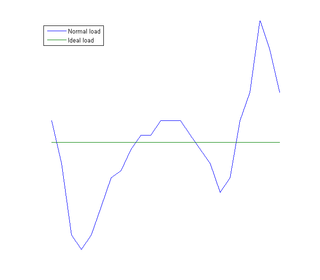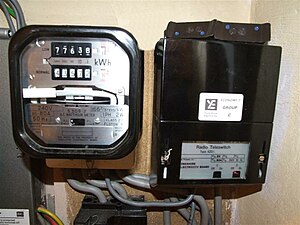Electricity retailing is the final sale of electricity from generation to the end-use consumer. This is the fourth major step in the electricity delivery process, which also includes generation, transmission and distribution.

Net metering is an electricity billing mechanism that allows consumers who generate some or all of their own electricity to use that electricity anytime, instead of when it is generated. This is particularly important with renewable energy sources like wind and solar, which are non-dispatchable. Monthly net metering allows consumers to use solar power generated during the day at night, or wind from a windy day later in the month. Annual net metering rolls over a net kilowatt-hour (kWh) credit to the following month, allowing solar power that was generated in July to be used in December, or wind power from March in August.

An electricity meter, electric meter, electrical meter, energy meter, or kilowatt-hour meter is a device that measures the amount of electric energy consumed by a residence, a business, or an electrically powered device.

A storage heater or heat bank (Australia) is an electrical heater which stores thermal energy during the evening, or at night when electricity is available at lower cost, and releases the heat during the day as required. Alternatively, solar storage heaters are designed to store solar energy as heat, to be released during the night or other periods where it is required, often making it more cost effective than selling surplus electricity to the grid and buying it back at night.
Energy demand management, also known as demand-side management (DSM) or demand-side response (DSR), is the modification of consumer demand for energy through various methods such as financial incentives and behavioral change through education.

Peaking power plants, also known as peaker plants, and occasionally just "peakers", are power plants that generally run only when there is a high demand, known as peak demand, for electricity. Because they supply power only occasionally, the power supplied commands a much higher price per kilowatt hour than base load power. Peak load power plants are dispatched in combination with base load power plants, which supply a dependable and consistent amount of electricity, to meet the minimum demand.

Demand response is a change in the power consumption of an electric utility customer to better match the demand for power with the supply. Until the 21st century decrease in the cost of pumped storage and batteries electric energy could not be easily stored, so utilities have traditionally matched demand and supply by throttling the production rate of their power plants, taking generating units on or off line, or importing power from other utilities. There are limits to what can be achieved on the supply side, because some generating units can take a long time to come up to full power, some units may be very expensive to operate, and demand can at times be greater than the capacity of all the available power plants put together. Demand response seeks to adjust the demand for power instead of adjusting the supply.

A radio teleswitch is a device used in the United Kingdom primarily to allow electricity suppliers to switch large numbers of electricity meters between different tariff rates, by broadcasting an embedded signal in broadcast radio signals. Radio teleswitches are also used to switch on/off consumer appliances to make use of cheaper differential tariffs such as Economy 7.

Electric heating is a process in which electrical energy is converted directly to heat energy at around 100% efficiency, using rather cheap devices. Common applications include space heating, cooking, water heating and industrial processes. An electric heater is an electrical device that converts an electric current into heat. The heating element inside every electric heater is an electrical resistor, and works on the principle of Joule heating: an electric current passing through a resistor will convert that electrical energy into heat energy. Most modern electric heating devices use nichrome wire as the active element; the heating element, depicted on the right, uses nichrome wire supported by ceramic insulators.
Zellweger is the brand name of an electric switching device also known as a Ripple Control Receiver used to control off-peak electrical loads such as water heaters by switching these loads OFF over peak energy use times of the day and switching them ON after peak energy use times of the day, hence the term 'off peak' control. It is an example of carrier current signaling. The Ripple Control Signal is generated at substations owned by Electricity Supply Authorities connected to the High Voltage transmission grid and injected into the Medium Voltage transmission grid at 11kV, 22kV, 33kV and 66kV, through a Coupling Cell consisting of a tuned L-C circuit. The Coupling Cell enables the Ripple Control Frequency to be superimposed on the 50 Hertz (Hz) mains frequency, which promulgates into the 415 V 3 phase power distribution lines providing energy to industrial and domestic customers of the Electricity Supply Authority. To avoid problems with other equipment connected to the distribution system ; i.e. industrial machinery and domestic appliances, the ripple frequency is selected to be offset from the third harmonic and its multiples, typically starting at 167 Hz and including, 217, 317, 425, 750, 1050, 1650. The choice of frequency depends upon the density of the load into which the ripple frequency is to be injected and the length of the distribution
A flat fee, also referred to as a flat rate or a linear rate refers to a pricing structure that charges a single fixed fee for a service, regardless of usage. Less commonly, the term may refer to a rate that does not vary with usage or time of use.
Economy 10 is the name of a tariff provided by United Kingdom electricity suppliers created in 2004. Similar to the Economy 7 this is designed to be used with high thermal mass heating such as storage heaters, underfloor heating, and is also used with electrical boilers driving radiators or water-based heat stores.

Load balancing, load matching, or daily peak demand reserve refers to the use of various techniques by electrical power stations to store excess electrical power during low demand periods for release as demand rises. The aim is for the power supply system to have a load factor of 1.
Financial incentives for photovoltaics are incentives offered to electricity consumers to install and operate solar-electric generating systems, also known as photovoltaics (PV).

Peak demand on an electrical grid is simply the highest electrical power demand that has occurred over a specified time period. Peak demand is typically characterized as annual, daily or seasonal and has the unit of power. Peak demand, peak load or on-peak are terms used in energy demand management describing a period in which electrical power is expected to be provided for a sustained period at a significantly higher than average supply level. Peak demand fluctuations may occur on daily, monthly, seasonal and yearly cycles. For an electric utility company, the actual point of peak demand is a single half-hour or hourly period which represents the highest point of customer consumption of electricity. At this time there is a combination of office, domestic demand and at some times of the year, the fall of darkness.
A feed-in tariff is a policy mechanism designed to accelerate investment in renewable energy technologies by offering long-term contracts to renewable energy producers. This means promising renewable energy producers an above-market price and providing price certainty and long-term contracts that help finance renewable energy investments. Typically, FITs award different prices to different sources of renewable energy in order to encourage development of one technology over another. For example, technologies such as wind power and solar PV are awarded a higher price per kWh than tidal power. FITs often include a "degression": a gradual decrease of the price or tariff in order to follow and encourage technological cost reductions.

Load management, also known as demand-side management (DSM), is the process of balancing the supply of electricity on the network with the electrical load by adjusting or controlling the load rather than the power station output. This can be achieved by direct intervention of the utility in real time, by the use of frequency sensitive relays triggering the circuit breakers, by time clocks, or by using special tariffs to influence consumer behavior. Load management allows utilities to reduce demand for electricity during peak usage times, which can, in turn, reduce costs by eliminating the need for peaking power plants. In addition, some peaking power plants can take more than an hour to bring on-line which makes load management even more critical should a plant go off-line unexpectedly for example. Load management can also help reduce harmful emissions, since peaking plants or backup generators are often dirtier and less efficient than base load power plants. New load-management technologies are constantly under development — both by private industry and public entities.

Electricity pricing can vary widely by country or by locality within a country. Electricity prices are dependent on many factors, such as the price of power generation, government taxes or subsidies, CO
2 taxes, local weather patterns, transmission and distribution infrastructure, and multi-tiered industry regulation. The pricing or tariffs can also differ depending on the customer-base, typically by residential, commercial, and industrial connections.
Differential tariff is an example of demand side management where the price per unit of energy varies with the consumption. If a power utility uses differential tariff, it may change the rate per kWH of energy used during different times, such as raising the price during times of high energy consumption and lowering the price during times of low energy consumption. This helps balance the rate at which power is used and the rate at which power is created.

Home energy storage devices store electricity locally, for later consumption. Electrochemical energy storage products, also known as "Battery Energy Storage System", at their heart are rechargeable batteries, typically based on lithium-ion or lead-acid controlled by computer with intelligent software to handle charging and discharging cycles. Companies are also developing smaller flow battery technology for home use. As a local energy storage technologies for home use, they are smaller relatives of battery-based grid energy storage and support the concept of distributed generation. When paired with on-site generation, they can virtually eliminate blackouts in an off-the-grid lifestyle.













